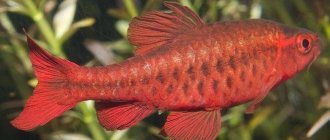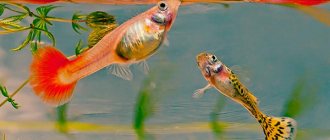Barbs in nature
In the wild, these interesting inhabitants of the underwater world are found in almost all bodies of water in Indonesia, China, Africa and India. Some species also live in the rivers of our country. The barb belongs to the genus of carp, most varieties of which are classified as commercial fish. Usually these are very large fish with unusually tasty meat. The varieties bred in aquariums are usually not particularly large in size. Their body length is most often no more than 5-7 cm.
Sumatran barbs
Most often, hobbyists keep unpretentious Sumatran barbs in aquariums. These are quite beautiful silver-colored fish with transverse black stripes on the body and a red lower fin. Albinos are also found among Sumatran barbs. The scales of the latter are cast in gold, and the stripes are white and almost invisible. The compatibility of barbs with other fish, if we are talking specifically about the Sumatran variety, raises doubts in many cases. You should select neighbors for these minke whales especially carefully. The fact is that this is the most aggressive variety.
Character traits by type
Sumatrans
Sumatran barb or striped robber, fish in a vest. The main feature of this species is 4 transverse stripes on the body, reminiscent of the color of a tiger. This miracle grows up to 7 cm. It is recommended to keep at least 7-8 individuals, since the fish are schooling, otherwise fights with neighbors and consequences in the form of damaged fins, serious injuries and even death of the fish cannot be avoided.
Scarlet Barbus
He is also the Odessa Barbus. This species is relatively peaceful, so it lives quietly with other neighbors, but it is still recommended to gather a company of 8-10 fish. Grows up to 6 cm.
Cherry barb
A rather small fish, growing up to 5 cm. The species is schooling and quite calm, but the males constantly strive to start a fight over the female they like, so it is better to keep more females. Of course, so that they don’t get bored and don’t bother their neighbors, they need to be kept in a group of at least 7 fish.
Barbus Denisoni
A very fastidious fish that can grow up to 15 cm in natural conditions and up to about 11 in an aquarium. She is very timid and is ready to jump out of the aquarium at the slightest fright, so a cover glass on the aquarium is a must. You need to keep at least 7 individuals.
Shark Ball
One of the largest types. Can grow up to 35 cm in natural conditions! In captivity, it is somewhat smaller, about 20 cm. Therefore, it must be kept in a spacious aquarium. Living in a huge glass box is boring for one fish, so it is advisable for it to share at least 2 friends of the same species. Bala does not show aggressiveness, but due to its significant size, it can mistake small neighbors for live food and eat them without a twinge of conscience.
Barbus eight-bar (eight-stripe)
A fairly unpretentious fish that grows up to 5 cm. The flock should consist of at least 6 individuals. The best option is 10-11.
Fire barb
A very beautiful species, somewhat reminiscent of a goldfish. The “veil” one is especially beautiful. This is the smallest known species. It grows to only 0.9-1 cm.
Barbus gold
It is also called green or Chinese. The fish is quite large compared to the previous one - 6-7 cm in length. But compared to the appearance of the shark ball, she is tiny.
Barbus linear
There are also 2 “branches” from this type: four-lane and five-lane. The fish are similar, the only difference is the number of stripes on the body: one has 4, and the other has 5. They are even smaller than the previous ones! (as if everything is going downhill here). These beauties reach a maximum length of 5 cm.
Barbus Ticto
Average (in size) species. It reaches 5-6 cm in length, like many members of the genus. Tiktos are very peaceful, so they can be planted with almost any fish (except veil fish).
Barbus black
A very interesting look with a gradient (from burgundy head to black tail). There are also even more beautiful veil subspecies. They are typical in length - 5 cm. The character is quite accommodating.
Schubert Barbus
An interesting species that resembles a golden koi carp. They get along well with non-aggressive species because they prefer the lower layers (they will have a bad time with crayfish, as the latter will start hunting them). The length is approximately 7 cm.
The size and color of all species can fluctuate and change. It all depends on the size of the aquarium, nutrition, frequency of water changes (you need to change at least 30% every week) and on the aggressiveness of the neighbors. All barbs should live in flocks of at least 6-7 individuals, but it is advisable to have more of them. Then there will be fewer complaints against their roommates: they will sort things out in the pack and will have no time for the others. The aquarium should be spacious so that there is enough space for everyone. It is necessary to plant a lot of plants, since the natural habitat of barbs is streams with dense vegetation . You need to create them so that the fish feels comfortable, can hide and sometimes eat them (for such purposes, it is best to breed hornwort, duckweed or ricci, which grow quickly and are full of vitamins the fish need).
Barbs "Mutant"
These fish can also often be seen in hobbyist aquariums. Their body shape is similar to the body shape of Sumatran barbs. The only difference is in color. This species can become a real decoration of your aquarium thanks to its bright dark green scales, red stigma and black fins with a red border. The character of green barbs is a little softer than that of Sumatran barbs, but you also need to choose the right neighbors for them.
Characteristics of barbs
As already mentioned, these fish are extremely active. Therefore, it is best for them to purchase an aquarium that is very elongated in length. The composition of the water does not play a special role for these fish. One of their main characteristics is unpretentiousness. Therefore, the compatibility of barbs with other fish, which are equally undemanding, quite active and not too aggressive, is not a question that raises any doubts. We’ll look at who exactly can join them in detail below.
Another feature of barbs is that they love to ruffle the long fins and tails of their neighbors in the aquarium. This should also be taken into account when selecting residents of your home underwater corner.
Good compatibility
In order to create friendly neighbors, it is worth paying attention to fast fish: zebrafish, thornets, congos, cichlazomas, diamond tetras and most catfish (speckled, tarakatumami). Sedentary fish, on the contrary, should not be allowed near barbs. Due to their character and appearance, bots, gouramis and swordtails are also suitable.
Botsiya
These fish are similar in many ways to barbs. They are fast and hate long fins. However, the loachfish can become aggressive towards other fish if it is alone in the aquarium. To solve this problem, it is worth keeping them in small flocks.
Swordtails
An active fish that loves to move quickly. Its disadvantage is its large fins, which attract barbs. At the same time, barbs get along well with them in a common aquarium, since the speed of these fish exceeds the restless predators. However, do not forget about aquatic plants to create shelters.
Danio rerio
Active and fast fish that live in schools. The absence of long fins and high speed of movement help to avoid quarrels.
Catfish
Due to the fact that barbs usually live in the upper or middle water layer, and catfish prefer a calm bottom, these fish do not have conflicts.
Gourami
Gourami is superior in size to barbs. The calmness and mobility characteristic of this fish helps it get along with these fidgets. However, you shouldn’t keep these fish with Sumatran fish, but the peace-loving cherry fish are perfect. It is also better to add the youngest representatives of the barb species to the gouras.
Barbs of different types
The best choice is to keep several types of barbs together (Sumatran and fire or cherry). The most peaceful and calm representative of the family is the green barb.
Barbs and angelfish
It is believed that these two species of fish do not get along very well in the same aquarium. However, in reality, in most cases it all depends on the conditions in that particular aquarium. If it has a significant volume (at least 100 l), coexistence of these two species of fish is possible. But then, when there are not too many barbs in the aquarium, and the angelfish are quite large. However, even under such conditions, the latter must be planted carefully. At first, you need to observe the behavior of the fish. Most likely, the angelfish will have to be removed from the aquarium soon. There will be less danger for them if they are planted in the aquarium first, and a little later add several barbs. In this case, the angelfish will feel in their territory. Active minke whales will still have to get used to it. Also, peaceful relations depend on the age at which barbs and angelfish were acquired. The compatibility of fish if they grew up together is beyond doubt among many aquarists.
Poor compatibility
As practice shows, the most unsuitable neighbors are slow-moving fish and individuals with long fins.
Angelfish
Barbs and scalars are not the best option for compatibility. Angelfish are slow and have fairly large fins, which attracts barbs.
Cockerels
Cockerels are distinguished by their cocky character and lush fins. When kept with barbs, there will be constant fights, which will lead to the loss of fins.
Guppy
Males with bushy tails will lose them on the very first day of living with barbs. In addition, barbs can kill guppies.
Lyalius
According to the description, laliuses are slow and quite timid, so the barbs will definitely not let them live in peace.
Astronotuses
Astronotuses are quite large and aggressive. They can harm barbs or even kill them.
Cichlids
Cichlids are true predators that can kill all fish. Only catfish are suitable as neighbors.
Neons
Neons and barbs are compatible, provided that the aquarium is large and has a lot of hiding places and live plants.
Barbs and neons
The compatibility of these two varieties with each other is also a rather controversial issue. Experts believe that such a neighborhood cannot end in anything particularly good. However, many aquarists actually have quite success keeping fish such as barbs and neons together. The compatibility of these two varieties actually depends on many factors. For example, if there are many plants planted in the aquarium, the neon will have somewhere to hide, and the barbs are unlikely to cause them significant harm. In principle, the rules for sharing in this case are the same as for angelfish. That is, it is better to add neons to barbs, and not vice versa, and buy fish at a very young age.
How to make friends between barbs and other fish
Cocky and eccentric pets have fun with other fish, attacking their small neighbors, tugging and plucking their fins. The victims experience great fear. Teaming up in packs and having a strong, fearless character helps them resist attacks. In order not to take risks, varieties of barbs are placed in the same aquarium, which they are even happy about.
Neighbors of barbs should be nimble and non-aggressive, have an external similarity, the same size and character. If you want to select fish based on similarity in color and temperament, avoid proximity to sedentary quiet and veiled-tailed fish. There is no need to pair your pets with larger and more predatory fish, which will offend and attack them.
Compatibility of barbs with various types of fish is possible subject to the following recommendations:
- Keep in a spacious, rectangular container with enough space for the fish to move and play. In close quarters, they start fighting for territory.
- A sufficient amount of greenery and shelter will help the fish hide from each other and not be annoying with their presence.
- Keeping several types of bullies in one aquarium will protect other fish from attacks while they deal with each other.
- Do not house them with viviparous fish. The bullies will chase the fry until they eat them all.
- Pets need to be fed in such a way that everyone has access to food and there is no need to fight for food.
- Active fidgets do not like veiled-tailed and slow-moving fish in the neighborhood. Barbs get close to them and damage their fins.
- Predators simply eat small aquarium fish and shrimp near them.
Good neighbors for barbs
Botsiya
The peaceful and nimble clown fish is similar in character and behavior to the barb and therefore gets along well with it. To achieve greater harmony, there should be several combatants. A single loachfish becomes aggressive over time. And Sumatran minke whales with loachfishes also have the same scale color and habitat, so they get along and look beautiful together.
Swordtails
Fast and energetic swordtails have an active behavior and are not inferior in speed to striped predators. The only irritating factor is the large fins, which can annoy neighbors. This problem can be solved by placing additional plants and shelters in the aquarium. During a chase, swordtails easily escape their pursuers.
Danio rerio
Schools of zebrafish are in constant motion and busy with their own affairs. They do not have long fins that can disturb their neighbors. Their fast movement helps to avoid contact and quarrels.
Gourami
Large and active gourami are endowed with a calm disposition, which helps to get along with fidgets. Of all the species, cherry gouramis live best. They begin to accustom them to each other by placing them with young fish hooligans.
Watch an interesting video about barbs and their compatibility.
Catfish
Catfish and barbs live on different tiers of the aquarium. They share nothing and get along well. Catfish are bottom-dwelling fish, while stripers live in the middle and upper layers of water. These two types of aquarium inhabitants do not conflict.
Pecilia
Barbs and platies can get along in the same aquarium. The only drawback is the appearance of offspring in these viviparous fish, which will quickly be eaten.
Compatibility of different types of barbs
Barbs have excellent compatibility with each other. Schubert's peaceful species gets along well with its relatives, as well as other species of fish. The Sumatran species has the hardest time finding neighbors. Sumatran, cherry and fiery species will get along with each other. The five-lined one will take root with the fiery one, and the red-lined one with the Sumatran one.
Lack of compatibility
Angelfish
Slow angelfish with large fins will irritate fidgets, who will definitely want to gnaw off their fins. Angelfish will also be dissatisfied with the fussiness and sudden movements of these fidgets.
However, some aquarists manage to keep these fish nearby. To do this, they use aquariums with a capacity of over 100 liters, add angelfish only in adulthood and a flock of barbs of 4 pieces.
First, release the angelfish into the aquarium to allow them to adapt and only after some time introduce the bully.
Cockerels
Cocky bettas with colorful, large fins and tails are cramped in a common home with other aggressive fish. Regular fights will result in the loss of fins.
Neons
Official sources deny the coexistence of neons with barbs. But experienced amateurs have proven in practice that this is possible. First of all, you need a sufficient number of plants and additional items where you can hide from the attacks of aggressors. Neons are placed in an aquarium with peace-loving green or cherry species, and not vice versa. Fish are taught to live together from a young age.
Guppy
Predatory pests will not leave calm guppies alone until they pluck their long fins and picturesque tails. Sometimes this ends in the death of small fish. Tolerant coexistence is observed when the aquarium is maximally filled with vegetation, including aquatic ferns, vallisneria, cambobs, grottoes, stones and shelters. There the baby guppies will rest from their pursuers.
Lyalius
They are too shy and immobile. They will be subject to constant attacks from their aggressive neighbors and experience stress.
Astronotuses
Large, smart and aggressive astronotuses will not get along with barbs. Pets will feel uncomfortable around cocky predators.
Cichlids
Predatory, aggressive cichlids are endowed with intelligence and will harass bullies. In this case, the barbs themselves will suffer.
The only option for coexistence is keeping young cichlids with adult representatives of cyprinids. After the fish grow up, they will have to be resettled. Even with apparent interaction, cichlid predators will begin to claim absolute dominance in the territory, which will end in skirmishes.
Restless and active barbs enliven the aquarium and delight the owner. In the case of sharing with other species of fish, one should not forget about their warlike nature and it is better to choose the most peaceful species, such as cherry, green, linear or black. With the right selection of inhabitants, the aquarium will be bright and attractive.
Interesting videos about barb compatibility
Barbs and guppies: compatibility
Guppies are perhaps the most beloved and popular fish among aquarists. Therefore, the question of whether it is possible to keep barbs together with them is quite natural. In fact, such a neighborhood usually does not end well. Guppies placed near barbs will most likely be driven to death. In the same case, if the fish grew up together, of course, nothing will happen to them. However, the owners of the aquarium will hardly be able to admire the beautiful fins of the guppy.
As mentioned above, barbs and neons, whose compatibility is also questionable, get along well together if there are many plants in the aquarium. The same applies to guppies. Plant more Vallisneria, Kambob, aquatic ferns, etc. in the aquarium, and they will have a place to hide from annoying striped or green neighbors.
What types of fish do they get along with?
There is a table that shows the most popular types of aquarium fish and shows the degree of their compatibility. The “+” sign means that the fish are compatible, the “-” sign means absolute incompatibility of the species, and the “0” sign means that it is possible to combine, but with some reservations.
According to the table, our “watchdogs” will get along well with swordtails, labeos, iridescents, plecostomus, rasboras, platies, loaches, gouramis, danios, corydoras and angelfish.
The best neighbors for them will be swordtails, which are not inferior to barbs either in activity or aggressiveness. Gourami and thorns are quite nimble and can fight back, so they can get along quite easily with barbs in the same aquarium.
Barbus fish: compatibility with cichlids
In this case, the aquarist should not expect good neighborly relations either. And this time it’s not about the barbs at all. Cichlids are perhaps the most aggressive fish of all, intended for home breeding in aquariums. They don't get along with practically anyone. The only fish they don’t touch are various kinds of bottom-dwelling catfish. You can only try to keep adult barbs and young cichlids together. After the latter grow up, it is best to remove them from the aquarium. Even being well acquainted with the local barbs, adult cichlids will not miss the opportunity to become the absolute masters of the territory.
What fish can you keep with?
Such fish as Sumatran barbs have very good compatibility with redfish. The behavior of the latter is similar to neon. However, they are not so whimsical and timid, and are practically not subject to stress. That's why they don't die from the slightest trifle. Among other things, the decorative qualities of the aquarium will also benefit from such a neighborhood. The transverse stripes of the Sumatran beauties go very well with the longitudinal zebrafish.
The compatibility of barbs with other fish is beyond doubt even when we are talking about representatives of characins. These could be, for example, ornathuses, minors, ternets or pristellas. Like cichlids, barbs do not touch various types of catfish. They also get along well with active swordtails. Being a little aggressive by nature, the latter, most likely, will not allow themselves to be offended. The same goes for gouramis and parrots.
The varieties mentioned above may well become very good neighbors for barbs. However, most often - for variety - simply different varieties are planted in aquariums at the same time. Sumatran, fiery, cherry, green barbs, etc. get along very well together.
With whom is shared housing contraindicated?
Veiltails, goldfish, neons and astronotuses do not get along at all in the same aquarium with barbs.
Veiltails have very beautiful and bright fins, which will undoubtedly attract the attention of the ubiquitous barbs. Calm veiltails are unlikely to be able to dodge them, so their fins will be bitten off quite quickly. In addition, the temperature regime for veiltails is somewhat different - they prefer cooler water than barbs.
Neons are gentle, sensitive fish that do not tolerate stressful situations well, so pugnacious barbs are not at all suitable as neighbors for them.
Barbs cannot be planted with astronotuses for completely the opposite reason.
Astronotuses are predators, and they have quite impressive sizes.
Little barbs will not be able to defeat them, and they will not be able to hide, since the astronotuses will find them everywhere. Most likely, in a very short period of time there will be no trace left of our flock of fidgets.
You will learn more about the care and maintenance of barbarus from the video.
Barbs are ray-finned spawn-marking fish from the carp family, representatives of the genus Barbus.
They have become popular in the aquarium hobby because of their unpretentiousness and variety of colors (now there are even fluorescent ones). They are nimble and fast, but carry the stigma of being “badass”. Some even consider them predatory, but this is far from the case. Proper compatibility of barbs with other fish is quite possible. It's all about the right neighbors and a suitable aquarium.
Barbs live 5-7 years, but during this long life for a fish, many of them can only grow up to 5 cm. Although the size of some species can range from 6 to 35 cm.
Fish in their natural environment live in rivers and streams with slow currents and warm water (25 degrees), sandy soil and dense vegetation, which must be created in the aquarium. Barbs like to burrow into the ground so that they do not harm themselves; there should be sand there, not large pebbles or crushed stone.
Content Features
Aquarium fish barbs, the compatibility of which with other species, as we have found out, largely depends on the conditions of keeping and growing, despite their unpretentiousness, they still require compliance with certain rules of care. Experts recommend:
- Keep them only in flocks.
- Be sure to plant more plants in the aquarium. They should become one of the sources of oxygen needed by barbs.
- The minimum aquarium volume for small-sized varieties (Sumatran, “mutants”, etc.) is 50 liters.
- It is definitely worth aeration and filtration.
- Barbs eat a lot. They should be fed frequently and in small portions. Food should be as varied as possible. This fish eats bloodworms, tubifex, cyclops, and daphnia very well. Dry food is also allowed from time to time. Cucumber gruel or finely chopped lettuce can also be a good food for barbs. Whether the fish have enough food can be judged by the condition of the aquarium plants. If they are plucked, it means that the quantity is not enough.
Factors Affecting Compatibility
When populating an aquarium with fish of various species, it is necessary to take into account the factors of their compatibility. These factors primarily include the degree of aggressiveness and territoriality of individual varieties.
Barbs, as already noted, are active and playful fish, in some cases even aggressive, so a spacious and preferably rectangular aquarium will be the best option for them.
The more free space, the lower the likelihood of barbs fighting with other species for territory.
These fish are big bullies, so very often other inhabitants of the aquarium living nearby hide from them. In order for them to have somewhere to hide in the aquarium from fidgety barbs, it is necessary to purchase green plants and artificial shelters. The denser the thickets in the aquarium, the healthier other types of fish will be.
In addition to those mentioned above, other factors of coexistence between different fish in the same aquarium are also of no small importance. For example, it is very important for our “heroes” to live in a pack. To divert the attention of barbs from other types of fish, it is better to purchase not one, but two or even three varieties of these fidgets. This way they will take care of each other and will pay less attention to their quieter neighbors.
In addition, under no circumstances should you place viviparous fish in the same aquarium with barbs . For barb predators, the fry are a delicacy, so they will not rest until they have destroyed everyone.
A factor such as layers of habitat of different species can help accommodate even fish that, it would seem, absolutely cannot live together. And all this is possible only because fish that prefer to spend time in the bottom layers are unlikely to be able to intersect with surface species.
And, of course, one of the basic rules is enough food . A deficiency can lead to fights. The food should be varied and in sufficient quantities. It is best to feed nimble fish of the described species with bloodworms, tubifex, cyclops and daphnia.
Reproduction
The barb, whose compatibility with other fish was discussed above, belongs to the spawn-marking class. At one time, the female can bring up to 500 eggs. Producers will need to be seeded before spawning. Particular attention should be paid to proper feeding at this time. Fish need to be given a lot of live food. After spawning, females are removed from the aquarium. The fry begin to be fed on the third day after hatching. Very young children are fed rotifers or artemia. In the future, larger types of food can be given. The fry should be fed very often, which is due to their very rapid growth.
Thus, the compatibility of barbs with other fish, active and non-aggressive, is beyond doubt. It is better not to house them together with representatives of the underwater world that are slow, timid, or have beautiful long or wide fins. If you want to see these beautiful, interesting, live fish in your aquarium, you should definitely take this into account. And, of course, you need to care for barbs correctly. In this case, there will be much fewer problems with their maintenance.











